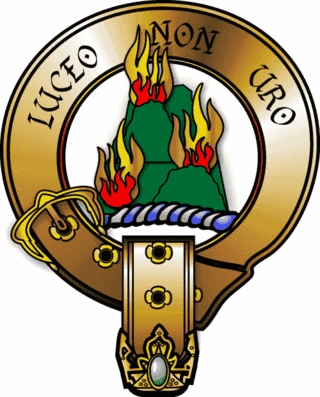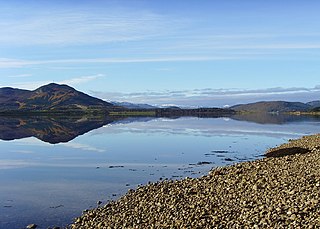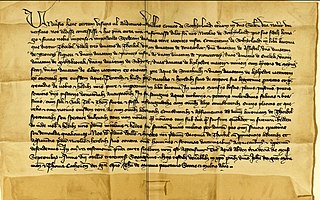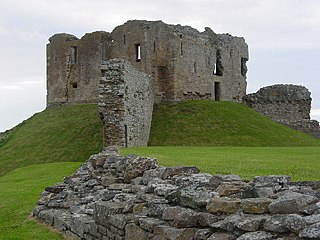
Kenneth Sutherland (died 1733–34) was the 3rd Lord Duffus, member of the Scottish nobility and a cadet of the Clan Sutherland.

Kenneth Sutherland (died 1733–34) was the 3rd Lord Duffus, member of the Scottish nobility and a cadet of the Clan Sutherland.
He was the eldest son of James Sutherland, 2nd Lord Duffus and Margaret, eldest daughter of Kenneth Mackenzie, 3rd Earl of Seaforth. [1] [2] [3]
He succeeded upon his father's death in 1705, but at the time was on service in the West Indies for the Crown during Queen Anne's War where he served as a captain in her Royal Navy. On 29 June 1711, with his own ship alone, which was a frigate with forty-six guns, he engaged eight French privateers, but after a desperate resistance he was taken prisoner having received five bullet wounds. [2] [3]
Although he had voted for the Acts of Union 1707, he still supported the Jacobites during the Jacobite rising of 1715. [1] [2] During the rising, he marched at the head of 500 men from the Clan Mackenzie, Clan Chisholm and Clan MacDonald to Tain where he proclaimed James VIII. He also attempted to make the Lairds of Culloden and Kilravock surrender their houses and arms, but without success. His estates were then forfeited and he fled abroad, apparently via Caithness and then onto Sweden. While he was there he learned that he was being searched for and prepared to surrender, declaring this intention to the British minister at Stockholm, who in turn notified the English Secretary of State. However, when he was on his way to England he was seized by order of the British resident at Hamburg and confined until the time for surrender had passed. He was then conveyed as a prisoner from Hamburg to the Tower of London but was freed without trial in 1717. [2] [3]
He later entered into service with the Russian Navy. He died before 18 March 1733–34. [2]
He married, by contract dated 30 March 1708, Charlotta Christina, daughter of Eric Sioblade, governor of Gothenburg. [1] Their children were: [2] [3]

Lord Lovat is a title of the rank Lord of Parliament in the Peerage of Scotland. It was created in 1458 for Hugh Fraser by summoning him to the Scottish Parliament as Lord Fraser of Lovat, although the holder is referred to simply as Lord Lovat. It was a separate title from the Scottish feudal lordship of Lovat, already held by the highland Frasers. In 1837 they were created a third title, Baron Lovat, of Lovat in the County of Inverness, in the Peerage of the United Kingdom. The holder is separately and independently the Chief of the highland Clan Fraser of Lovat.

Earl of Cromartie is a title that has been created twice, both for members of the Mackenzie family. It was first created as Earl of Cromarty in the Peerage of Scotland in 1703 for Sir George Mackenzie, 2nd Baronet, but his titles were forfeited after the Jacobite rising of 1745. It was recreated in 1861 in the Peerage of the United Kingdom for Anne Sutherland-Leveson-Gower, Duchess of Sutherland. Since 1979, the Earl of Cromartie has been chief of Clan Mackenzie.

Clan Mackenzie is a Scottish clan, traditionally associated with Kintail and lands in Ross-shire in the Scottish Highlands. Traditional genealogies trace the ancestors of the Mackenzie chiefs to the 12th century. However, the earliest Mackenzie chief recorded by contemporary evidence is Alexander Mackenzie of Kintail who died some time after 1471. Traditionally, during the Wars of Scottish Independence, the Mackenzies supported Robert the Bruce, but feuded with the Earls of Ross in the latter part of the 14th century. During the 15th and 16th-centuries the Mackenzies feuded with the neighboring clans of Munro and MacDonald. In the 17th century the Mackenzie chief was made Earl of Seaforth in the peerage of Scotland. During the Scottish Civil War of the 17th century the Mackenzies largely supported the Royalists. During the Jacobite rising of 1715 the chief and clan of Mackenzie supported the Jacobite cause. However, during the Jacobite rising of 1745 the clan was divided with the chief, Kenneth Mackenzie, Lord Fortrose, supporting the British-Hanoverian Government and his relative, George Mackenzie, 3rd Earl of Cromartie, supporting the Jacobites.

Clan Sutherland also known as House of Sutherland is a Highland Scottish clan whose traditional territory is the shire of Sutherland in the far north of Scotland. The chief of the clan was also the powerful Earl of Sutherland, however in the early 16th century this title passed through marriage to a younger son of the chief of Clan Gordon. The current chief is Alistair Sutherland who holds the title Earl of Sutherland.

Clan Sinclair is a Highland Scottish clan which holds the lands of Caithness, the Orkney Islands, and the Lothians. The chiefs of the clan were the Barons of Roslin and later the Earls of Orkney and Earls of Caithness.

Clan Chisholm is a Highland Scottish clan.

The title Lord Duffus was created by Charles II in the Peerage of Scotland on 8 December 1650 for Alexander Sutherland. He was a descendant of the 4th Earl of Sutherland, who fell in battle in 1333. The title is now extinct, although there may be male-line Sutherlands descended from earlier lairds of Duffus.
Kenneth Mackenzie, 4th Earl of Seaforth, KT, PC (S) was a Scottish peer and Jacobite supporter, known as Lord Mackenzie of Kintail from birth until 1678.

John Mackenzie, Lord MacLeod was a Scottish Jacobite politician and soldier of fortune.
William Sutherland, 17th Earl of Sutherland, previously named William Gordon, 17th Earl of Sutherland,, was a Scottish politician who sat in the House of Commons from 1727 until 1733 when he succeeded to the peerage as Earl of Sutherland. He was chief of the Clan Sutherland, a Scottish clan of the Scottish Highlands.
The Independent Highland Companies were irregular militia raised from the Scottish clans of the Scottish Highlands by order of the British government between 1603 and 1760 in order to help keep the peace and enforce the law in the Highlands and were recognized as such by the government. The officers of the Independent Highland Companies were commissioned as officers of the British Army but the Independent Companies were not recognized as official regiments of the line of the army. The Independent Highland Companies were the progenitors of the Highland Regiments of the British Army that began when ten Independent Highland Companies were embodied to form the Earl of Crawford's Highland Regiment that was numbered the 43rd Regiment of Foot in 1739.

The Battle of Dornoch took place on 20 March 1746 and was part of the Jacobite rising of 1745 in Scotland. However, although recorded in history as a "battle" there was no actual fighting between the two sides. Instead a large rebel Jacobite force advanced on a position held by a force loyal to the British-Hanoverian Government who were taken by surprise and forced into a retreat. The Jacobite advance was coordinated by James Drummond, 3rd Duke of Perth at Dornoch, Sutherland.

Nicholas Sutherland, 1st of Duffus was a Scottish noble who was seated at Duffus Castle, near Elgin, Moray, Scotland in the 14th and 15th centuries.

Alexander Sutherland was the 1st Lord Duffus, a member of the Scottish nobility and a cadet of the Clan Sutherland.

William Sutherland, 5th of Duffus was a member of the Scottish nobility and a cadet of the Clan Sutherland.

Alexander Sutherland, 8th of Duffus was a member of the Scottish nobility and a cadet of the Clan Sutherland.

William Sutherland, 9th of Duffus was a member of the Scottish nobility and a cadet of the Clan Sutherland.

William Sutherland, 10th of Duffus was a member of the Scottish nobility and a cadet of the Clan Sutherland.

James Sutherland was the 2nd Lord Duffus, member of the Scottish nobility and a cadet of the Clan Sutherland.
Eric Sutherland was the 4th Lord Duffus, member of the Scottish nobility and a cadet of the Clan Sutherland.